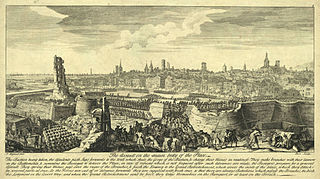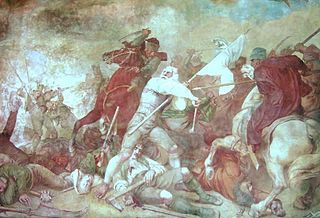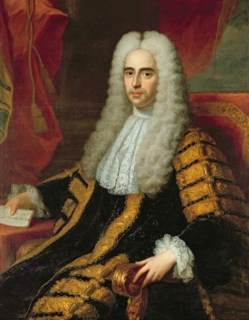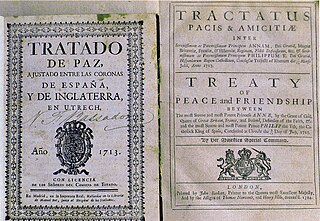 W
WThe War of the Spanish Succession (1701–1714) was an early 18th century European war, triggered by the death in November 1700 of the childless Charles II of Spain. It established the principle dynastic rights were secondary to maintaining the balance of power between different countries. Related conflicts include the 1700-1721 Great Northern War, Rákóczi's War of Independence in Hungary, the Camisard revolt in southern France, Queen Anne's War in North America and minor struggles in Colonial India.
The Army of the Principality of Catalonia was the army raised by the General Estates of Catalonia on July 9, 1713 after the English treason with the Treaty of Utrecht and the withdrawal of Imperial troops by the L'Hospitalet Agreement. The army was made up of 10,000 infantry, 1,600 cavalry and 1,000 naval troops. It is not known how many men formed the artillery unit but it did not exceed 700. In total, the army contained 13,000 regular troops.
 W
WThe Siege of Barcelona took place between 14 September and 19 October 1705 during the War of the Spanish Succession when a multinational Grand Alliance army led by Lord Peterborough, supporting the Habsburg pretender to the Spanish throne, captured the city of Barcelona from its Spanish Bourbonic defenders, most of whom then joined the Habsburg army.
 W
WThe Siege of Barcelona was a battle at the end of the War of Spanish Succession, which pitted Archduke Charles of Austria against Philip V of Spain, backed by France in a contest for the Spanish crown.
 W
WThe Battle of Almansa was a campaign fought as part of the War of the Spanish Succession. It took place on 25 April 1707 between the forces of Philip V of Spain, Bourbon, claimant to the Spanish throne, and his Habsburg rival, Archduke Charles of Austria. The result was a decisive Bourbon victory that reclaimed most of eastern Spain for Philip.
 W
WThe Bavarian uprising of 1705–06 was a revolt against the occupation of the Electorate of Bavaria by the forces of the Austrian Habsburgs during the War of Spanish Succession (1701–14). It lasted from early November 1705 to 18 January 1706, approximately 75 days. Henric L. Wuermeling speaks of this as "the first revolution of modern history."
 W
WThe Sieges of Ceuta were a series of blockades by Moroccan forces of the Spanish-held city of Ceuta on the North African coast. The first siege began on 23 October 1694 and finished in 1720 when reinforcements arrived. During the 26 years of the siege, the city underwent changes leading to the loss of its Portuguese character. While most of the military operations took place around the city walls, there were also small-scale penetrations by Spanish forces at various points on the Moroccan coast, and the seizure of shipping in the Strait of Gibraltar. The city was placed under a second siege in 1721 until 22 April 1727.
 W
WThe Ettlingen Line or Lower Line was a defensive line built in 1707 during the War of the Spanish Succession from brushwood (Verhauen) and palisades, which replaced the 1701 Bühl-Stollhofen Line after that had been destroyed in May 1707 and levelled by French troops.
 W
WReinhard Vincent Graf von Hompesch was a general of German origin in the service of the United Provinces, and governor firstly of Luxembourg, then Namur and lastly of ’s-Hertogenbosch. His parents were Johann Dietrich II von Hompesch zu Bollheim and Rurich and Anna Louisa von Ketzgen.
 W
WFrom 1700 to 1720, the Kingdom of Sardinia, as a part of the Spanish empire, was disputed between two dynasties, the Habsburgs and the Bourbons. With the death of Charles II, the last of the Spanish Habsburgs, on 1 November 1700, the throne passed to Duke Philip of Anjou, although the Emperor Leopold I also had a claim. Leopold was especially desirous of obtaining the Spanish inheritance in the Southern Netherlands and in Italy, which included Sardinia. With the failure of France to abide by the Second Partition Treaty, the other European powers lined up on the side of the Habsburgs. The Treaty of the Hague allotted to the Emperor the Spanish possessions in Italy. Imperial troops invaded Italy to seize them, and the War of the Spanish Succession began.
 W
W"Marlbrough s'en va-t-en guerre" or "Malbrook s'en va-t-en guerre" is a popular folk song in French.
 W
WThe Methuen Treaty was a military and commercial treaty between England and Portugal that was signed in 1703 as part of the War of the Spanish Succession.
 W
WJuan Francisco Pacheco y Téllez-Girón, 4th Consort Duke of Uceda,, was a Spanish noble, viceroy of Sicily and Spanish Ambassador in Rome.
 W
WQueen Anne's War (1702–1713) was the second in a series of French and Indian Wars fought in England's Thirteen American Colonies during the reign of Anne, Queen of Great Britain. In Europe, it is generally viewed as the American theater of the War of the Spanish Succession; in the Americas, it is more commonly viewed as a standalone conflict. It is also known as the Third Indian War or as the Second Intercolonial War in France.
 W
WThe Treaty of Baden ended formal hostilities between Kingdom of France and the Holy Roman Empire, which had been at war since the start of the War of the Spanish Succession. The treaty was signed on 7 September 1714 in Baden, Switzerland, and complemented the Treaties of Utrecht and Rastatt.
 W
WThe Peace of Utrecht is a series of peace treaties signed by the belligerents in the War of the Spanish Succession, in the Dutch city of Utrecht between April 1713 and February 1715. The war involved three contenders for the vacant throne of Spain, and involved much of Europe for over a decade. The main action saw France as the defender of Spain against a multinational coalition. The war was very expensive and bloody and finally stalemated. Essentially, the treaties allowed Philip V to keep the Spanish throne in return for permanently renouncing his claim to the French throne, along with other necessary guarantees that would ensure that France and Spain should not merge, thus preserving the balance of power in Europe.
 W
WThe Verdes-Montenegro family was a prominent Spanish family of Galician origins, some of whose members held relevant government and church positions during the most part of the 18th century. Members of the family joined the high Spanish nobility by marriage and their descendants still live in Spain.